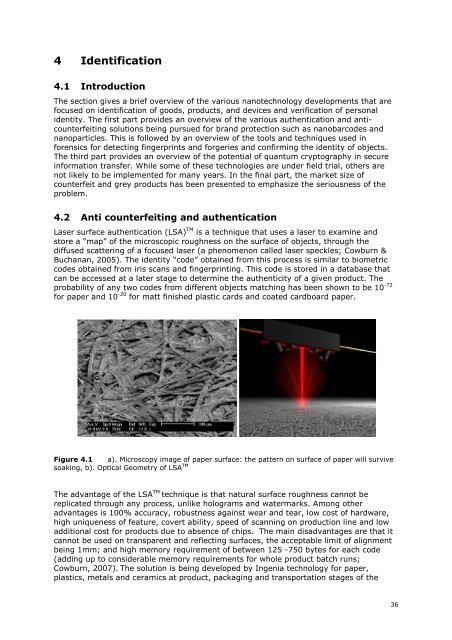Download - Nanowerk
Download - Nanowerk
Download - Nanowerk
You also want an ePaper? Increase the reach of your titles
YUMPU automatically turns print PDFs into web optimized ePapers that Google loves.
4 Identification<br />
4.1 Introduction<br />
The section gives a brief overview of the various nanotechnology developments that are<br />
focused on identification of goods, products, and devices and verification of personal<br />
identity. The first part provides an overview of the various authentication and anticounterfeiting<br />
solutions being pursued for brand protection such as nanobarcodes and<br />
nanoparticles. This is followed by an overview of the tools and techniques used in<br />
forensics for detecting fingerprints and forgeries and confirming the identity of objects.<br />
The third part provides an overview of the potential of quantum cryptography in secure<br />
information transfer. While some of these technologies are under field trial, others are<br />
not likely to be implemented for many years. In the final part, the market size of<br />
counterfeit and grey products has been presented to emphasize the seriousness of the<br />
problem.<br />
4.2 Anti counterfeiting and authentication<br />
Laser surface authentication (LSA) TM is a technique that uses a laser to examine and<br />
store a “map” of the microscopic roughness on the surface of objects, through the<br />
diffused scattering of a focused laser (a phenomenon called laser speckles; Cowburn &<br />
Buchanan, 2005). The identity “code” obtained from this process is similar to biometric<br />
codes obtained from iris scans and fingerprinting. This code is stored in a database that<br />
can be accessed at a later stage to determine the authenticity of a given product. The<br />
probability of any two codes from different objects matching has been shown to be 10 -72<br />
for paper and 10 -20 for matt finished plastic cards and coated cardboard paper.<br />
Figure 4.1 a). Microscopy image of paper surface: the pattern on surface of paper will survive<br />
soaking, b). Optical Geometry of LSA TM<br />
The advantage of the LSA TM technique is that natural surface roughness cannot be<br />
replicated through any process, unlike holograms and watermarks. Among other<br />
advantages is 100% accuracy, robustness against wear and tear, low cost of hardware,<br />
high uniqueness of feature, covert ability, speed of scanning on production line and low<br />
additional cost for products due to absence of chips. The main disadvantages are that it<br />
cannot be used on transparent and reflecting surfaces, the acceptable limit of alignment<br />
being 1mm; and high memory requirement of between 125 -750 bytes for each code<br />
(adding up to considerable memory requirements for whole product batch runs;<br />
Cowburn, 2007). The solution is being developed by Ingenia technology for paper,<br />
plastics, metals and ceramics at product, packaging and transportation stages of the<br />
36

















